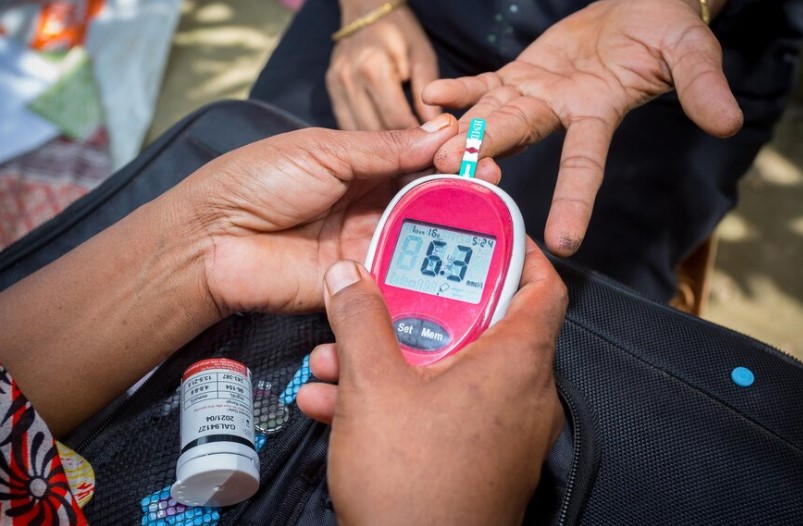
Diabetes and vascular disease are two interconnected health conditions that often go hand in hand, significantly impacting the lives of millions of people worldwide. Vascular disease refers to conditions that affect the blood vessels, including arteries, veins, and capillaries, while diabetes is a metabolic disorder characterized by high blood sugar levels. The relationship between diabetes and vascular disease is complex and multifaceted, with diabetes serving as a major risk factor for the development and progression of various vascular conditions. In this blog, we will delve into the link between diabetes and vascular disease, exploring the mechanisms underlying their association, common vascular complications of diabetes, and strategies by Best vascular surgeon in Patiala for prevention and management.
Understanding Diabetes and Vascular Disease:
Before delving into the link between diabetes and vascular disease, it’s essential to understand the nature of these two conditions individually.
Diabetes:
Diabetes is a chronic metabolic disorder characterized by elevated blood sugar levels, resulting from either insufficient insulin production by the pancreas (Type 1 diabetes), resistance to insulin action in target tissues (Type 2 diabetes), or a combination of both. Insulin is a hormone produced by the pancreas that helps regulate blood sugar levels and facilitates the uptake of glucose into cells for energy production.
Uncontrolled diabetes can lead to a range of complications affecting various organs and systems in the body, including the cardiovascular system, nervous system, kidneys, eyes, and feet. Cardiovascular complications are particularly common in individuals with diabetes and are a leading cause of morbidity and mortality in this population.
Vascular Disease:
Vascular disease encompasses a group of conditions that affect the blood vessels, impairing their structure and function. Common types of vascular disease include:
- Atherosclerosis: Atherosclerosis is a progressive condition characterized by the buildup of fatty deposits (plaques) within the walls of arteries, leading to narrowing and hardening of the arteries. This can restrict blood flow to vital organs and tissues, increasing the risk of heart attack, stroke, and peripheral artery disease.
- Peripheral Artery Disease (PAD): PAD is a type of vascular disease that affects the arteries supplying the legs and feet. It is characterized by reduced blood flow to the lower extremities, resulting in symptoms such as leg pain, numbness, and weakness, particularly during physical activity.
- Coronary Artery Disease (CAD): CAD is a type of vascular disease that affects the arteries supplying the heart muscle. It can lead to chest pain (angina), heart attack, heart failure, and arrhythmias (irregular heart rhythms) due to reduced blood flow to the heart.
The Link Between Diabetes and Vascular Disease:
The relationship between diabetes and vascular disease is bidirectional, with each condition exacerbating the risk and severity of the other. Several mechanisms contribute to the link between diabetes and vascular disease:
Insulin Resistance and Hyperglycemia:
In Type 2 diabetes, insulin resistance and hyperglycemia (elevated blood sugar levels) contribute to the development and progression of vascular disease. Insulin resistance impairs the body’s ability to effectively utilize insulin, leading to compensatory increases in insulin production by the pancreas. Chronic hyperglycemia promotes inflammation, oxidative stress, and endothelial dysfunction, which contribute to the development of atherosclerosis and other vascular abnormalities.
Dyslipidemia:
Individuals with diabetes often have dyslipidemia, characterized by abnormal levels of lipids (fats) in the blood, including elevated levels of triglycerides and low-density lipoprotein (LDL) cholesterol and decreased levels of high-density lipoprotein (HDL) cholesterol. Dyslipidemia contributes to the formation of atherosclerotic plaques and increases the risk of cardiovascular events such as heart attack and stroke.
Hypertension:
Hypertension (high blood pressure) is common in individuals with diabetes and is a major risk factor for vascular disease. Chronic elevation of blood pressure damages the walls of blood vessels, increasing the risk of atherosclerosis, arterial stiffness, and endothelial dysfunction. Hypertension further accelerates the progression of vascular disease in individuals with diabetes, leading to an increased risk of cardiovascular complications.
Inflammation and Oxidative Stress:
Chronic inflammation and oxidative stress play key roles in the pathogenesis of both diabetes and vascular disease. In diabetes, hyperglycemia and insulin resistance promote inflammatory responses and oxidative damage within blood vessels, contributing to endothelial dysfunction and atherosclerosis. Similarly, vascular inflammation and oxidative stress exacerbate insulin resistance and impair glucose metabolism, creating a vicious cycle of metabolic and vascular dysfunction.
Common Vascular Complications of Diabetes:
Diabetes significantly increases the risk of developing various vascular complications, which can have profound consequences for health and quality of life. Some of the most common vascular complications of diabetes include:
Coronary Artery Disease (CAD):
Individuals with diabetes are at increased risk of developing CAD, a condition characterized by the narrowing and hardening of the coronary arteries that supply blood to the heart muscle. CAD can lead to chest pain (angina), heart attack (myocardial infarction), heart failure, and sudden cardiac death.
Peripheral Artery Disease (PAD):
PAD is a common vascular complication of diabetes that affects the arteries supplying the legs and feet. It is characterized by reduced blood flow to the lower extremities, leading to symptoms such as leg pain, numbness, tingling, and weakness, particularly during physical activity. PAD can also increase the risk of foot ulcers, infections, and non-healing wounds, which can ultimately result in limb amputation in severe cases.
Cerebrovascular Disease:
Diabetes is a major risk factor for cerebrovascular disease, which includes conditions such as stroke and transient ischemic attack (TIA), also known as “mini-stroke.” Cerebrovascular disease occurs when blood flow to the brain is disrupted due to blockage or rupture of blood vessels, leading to neurological deficits such as weakness, numbness, speech disturbances, and cognitive impairment.
Diabetic Retinopathy:
Diabetic retinopathy is a complication of diabetes that affects the blood vessels in the retina, the light-sensitive tissue at the back of the eye. It is a leading cause of vision loss and blindness among adults with diabetes. Diabetic retinopathy can cause changes in vision, including blurriness, floaters, and eventual vision loss if left untreated.
Diabetic Nephropathy:
Diabetic nephropathy is a type of kidney disease that occurs as a complication of diabetes. It is characterized by damage to the small blood vessels in the kidneys, leading to impaired kidney function and the accumulation of waste products and fluid in the body. Diabetic nephropathy can progress to end-stage renal disease (ESRD), requiring dialysis or kidney transplantation for survival.
Prevention and Management Strategies:
Preventing and managing vascular complications in individuals with diabetes requires a comprehensive approach that addresses underlying risk factors and promotes optimal vascular health. Some strategies for prevention and management include:
Glycemic Control:
Achieving and maintaining tight glycemic control is essential for reducing the risk of vascular complications in individuals with diabetes. Monitoring blood sugar levels regularly, adhering to a healthy diet, engaging in regular physical activity, and taking medications as prescribed can help stabilize blood sugar levels and minimize the risk of hyperglycemia-related vascular damage.
Blood Pressure Management:
Controlling hypertension is crucial for preventing vascular complications in individuals with diabetes. Lifestyle modifications such as adopting a low-sodium diet, maintaining a healthy weight, limiting alcohol intake, and engaging in regular exercise can help lower blood pressure levels. Medications such as angiotensin-converting enzyme (ACE) inhibitors, angiotensin II receptor blockers (ARBs), diuretics, and calcium channel blockers may also be prescribed to manage hypertension effectively.
Lipid Management:
Managing dyslipidemia is essential for reducing the risk of atherosclerotic vascular disease in individuals with diabetes. Lifestyle interventions such as adopting a heart-healthy diet, increasing physical activity, quitting smoking, and maintaining a healthy weight can help improve lipid profiles and reduce the risk of cardiovascular events. Medications such as statins, fibrates, and cholesterol absorption inhibitors may also be prescribed to lower LDL cholesterol and triglyceride levels and raise HDL cholesterol levels.
Smoking Cessation:
Quitting smoking is one of the most effective ways to reduce the risk of vascular complications in individuals with diabetes. Smoking damages blood vessels, promotes inflammation, and accelerates the progression of atherosclerosis, increasing the risk of heart attack, stroke, PAD, and other vascular conditions. Smoking cessation interventions, including counseling, nicotine replacement therapy, and prescription medications, can help individuals quit smoking and improve their vascular health.
Regular Monitoring and Screening:
Regular monitoring and screening for vascular complications are essential for detecting early signs of disease and implementing appropriate interventions to prevent progression. Individuals with diabetes should undergo regular check-ups with their healthcare providers, including comprehensive physical examinations, blood tests, and diagnostic imaging studies as needed to assess vascular health and identify any potential complications.
Conclusion:
The link between diabetes and vascular disease is complex and multifaceted, with diabetes serving as a major risk factor for the development and progression of various vascular conditions. Chronic hyperglycemia, insulin resistance, dyslipidemia, hypertension, inflammation, and oxidative stress contribute to the pathogenesis of vascular complications in individuals with diabetes, increasing the risk of cardiovascular events, peripheral artery disease, stroke, and other vascular conditions.
Preventing and managing vascular complications in individuals with diabetes requires a multidisciplinary approach that addresses underlying risk factors, promotes optimal glycemic control, blood pressure management, lipid management, smoking cessation, and regular monitoring and screening for vascular disease. By implementing comprehensive strategies to reduce vascular risk, individuals with diabetes can minimize the impact of vascular complications on their health and quality of life and improve long-term outcomes. Looking for the best vascular surgery hospital? Contact us today or schedule an appointment with vascular surgeon in Patiala.



















